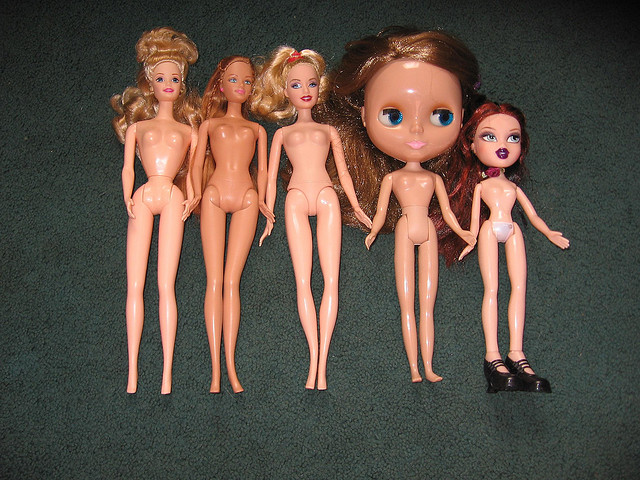There was a conversation at work a few months ago about brides-to-be dieting to extremes to fit into their wedding dresses.
We bantered back and forth, swapping stories about this nightmare diet we’d heard of, or that girl we knew who had lost xx lbs in xx weeks to squeeze into her gown.
Then, from the other end of the desks, a girl piped up, a face full of earnest confusion, “But wait. I don’t get it. Why don’t they just get a dress that fits?”
We blinked. A pause. Then an explosion of laughing.
But, of course. Why don’t we just buy clothes that fit?
This got me thinking about the whole ridiculous way we label our bodies and the many, many ways we’re built.
The sizing chart
First, there are the numbers we use to categorize our shapes and sizes. And even then, the numbers differ vastly. In the United States, I’m a size six; in Australia, I’m a size eight; in the UK, I’m a size 10. In some random stores in Malaysia, who choose an altogether different system of numbering, I am anything from a nine and a 17.
Or whatever.
Then we get ourselves in a big jumble when we can’t get into a certain size. I’ve spent a good number of precious hours fretting over why a size 10 no longer zips up as smoothy as it did before. I waste good energy feeling ashamed to ask the sales assistant for a dress in the next size up, as if a number lights up in neon across every piece of clothing I’m wearing. (And who cares if it did anyway?)
Even if we do manage to fit into that exact size we’ve conjured up as being ideal, that’s still no guarantee that that dress/top/skirt will look good on us. There’s also style, cut, colour, our individual personalities, and a whole bunch of other things that go into rockin’ an outfit, which have nothing to do with the number on a tiny tag that nobody will see.
The fruit chart
Then, as if numbering hasn’t been sadistic enough as a device, there’s also the fruit chart. You know, those maddening magazine articles, with images of women in their underwear each labelled as ‘pear-shaped’, ‘apple-shaped’ or ‘lemon-shaped’.
As readers, we’re prompted to stand in front of our own mirrors in our underwear, and study our bodies and the magazine guide to determine which winning fruit it is that we most resemble.
It’s not good enough to have just compared ourselves to a bulbous plant. The ‘experts’ then advise us on the types of exercise we should do, the diets to follow, the clothes to wear to make the most of out of looking like whichever spectacular fruit it is we’re emulating.
But while I love a good apple crumble, a scrummy baked pear or a lemon meringue pie (extra meringue) and am all for the goody goodness of having more fruit in our diets, I have to say I completely disagree with identifying ourselves after them.
No. I protest.
I don’t agree with whittling down millions of uniquely formed bodies into just a few generic categories.
We all boast different sizes and shapes and physiological make-ups. We’re each such remarkably unique hybrids of physical difference that I think it’s impossible to just plonk us into one of a few labels and say, ‘Here. You’re this-shaped so you need this method and these exercises and those tapered trousers to make you look better.’
I’ll eat whatever the damn hell I want and dress however I feel like today. Even if it makes me look like a lemon. Heck, maybe because it makes me look like a lemon. Thank you.
We each have our own, special, identifiably singular body shape. We each react to foods and movement very differently and for reasons that go far beyond the shapes our bodies have assumed. One very skinny girl may reach her optimal physical fitness doing yoga; another may find it in running. A chubby girl may find that she feels in her best health when she’s on a vegan diet; another, when she eats meat every meal. One sporty, muscly girl may feel her sexiest wearing scrappy jeans and a tank top; while another feels more body-confident in a mini dress.
How silly it is to ascribe specific modes of behaviour and habits to what is an infinitely broad spectrum of body types.
It is also damaging—for what if a girl is told she is ‘pear-shaped’ but is completely uncomfortable following any of the subsequent advice for eating, working-out and dressing? What if it doesn’t actually suit her body’s needs or affects her health adversely? Is she then to believe that she’ll just have to make do with ‘looking like a pear’ for the rest of whenever?
And anyway, what’s wrong with looking the way she does right now—pear, apple, squashed potato?
Why is there always that horribly implied message that whatever shape we are, there is something that needs fixing? Something to improve? (unless there are valid health concerns and reasons, of course)
So, no. I protest. I protest against identifying ourselves with any numbered cloth tags or alphabets or fruits or shapes.
I have only one way to describe the way I am:
I am Jamie-shaped.
And I will lift weights if I want to, or do yoga, or dance. Or maybe just blob about in the sun by the pool. I will wear a cotton maxi-dress if it takes my fancy, or a tulle frock; a flared gypsy skirt or a pencil skirt; a tailored suit or baggy jeans. I will eat carbs and protein and sugary biscuits, perhaps altogether.
For I have only one body, and it is all and entirely mine.
Love elephant and want to go steady?
Sign up for our (curated) daily and weekly newsletters!
Editor: Renée Picard
Photo: susan402/Flickr Creative Commons











Read 4 comments and reply